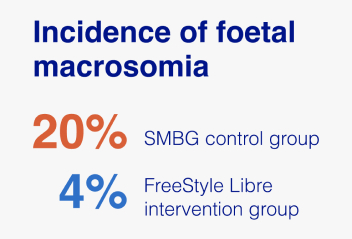FLAMINGO study
FreeStyle Libre use in gestational diabetes mellitus
Evaluating the FreeStyle Libre system in pregnant women with gestational diabetes
Hyperglycaemia affects 15% of pregnant women in Europe1 and is a risk factor for maternal and foetal complications during pregnancy, including foetal macrosomia.2
FLAMINGO was a randomised controlled trial (RCT) that analysed the effects of the FreeStyle Libre flash glucose monitoring system compared to self-monitoring of blood glucose (SMBG) on glycaemic control and perinatal outcomes in pregnant women with gestational diabetes mellitus (GDM).3
FreeStyle Libre use impacted glycaemic control, dietary habits and reduced the incidence of foetal macrosomia compared with SMBG in pregnant women with GDM.
Study objective
To evaluate the efficacy of the FreeStyle Libre system in GDM management.
Study design and study population
FLAMINGO was a non-blinded RCT designed to assess the efficacy of flash glucose monitoring in GDM.
Study enrolment occurred between March, 2020 and October, 2022 at the 1st Department of Obstetrics and Gynaecology, Medical University of Warsaw, Poland.
One hundred pregnant women (aged >18) diagnosed with GDM between 24–28 weeks of gestation were enrolled and randomly assigned (1:1) to either the intervention group (flash glucose monitoring, n=50, out of which 49 completed the study) or the control group (SMBG, n=50).
The intervention group used the FreeStyle Libre system for the first 4 weeks after GDM diagnosis, followed by SMBG for the remainder of the pregnancy, whilst the control group used SMBG throughout the entire study period until birth.
After recruitment, the participants were followed up at four visits (2 and, 4 weeks after recruitment, 34–36 weeks of gestation and postpartum). During the three follow up visits, clinical and laboratory data were assessed, including glucose concentrations, qualification for insulin therapy and dosage, diet habits, physical activity and gestational weight gain. A1c levels and ultrasound estimated foetal weight were measured at the second and third follow up visits.
Perinatal outcomes, including weeks of gestation, route of birth, newborn weight and neonatal hypoglycaemic events, were assessed in the 4th follow up visit.
 Key Inclusion criteria*
Key Inclusion criteria*
 Key Inclusion criteria*
Key Inclusion criteria*- Participant’s age >18 years old
- Diagnosed with GDM between 24–28 weeks of gestation (fasting plasma glucose 92–126 mg/dL; 1-hour glucose concentration ≥180 mg/dL; or 2-hour glucose concentration 153–199 mg/dL)
- Singleton pregnancy
 Key Exclusion criteria*
Key Exclusion criteria*
 Key Exclusion criteria*
Key Exclusion criteria*- Foetal malformations
- Pre-gestational diabetes
- Physiologic risk factors and medications with potential impact on pregnancy outcome
- Multiple pregnancy
 Primary outcome
Primary outcome
 Secondary outcomes
Secondary outcomes
Study results
Key patient baseline characteristics
The study included 100 participants randomised in to two study arms (FreeStyle Libre, intervention arm [n=49]); SMBG, control arm [n=50]). There was no significant difference in maternal baseline characteristics between the two groups.
IQR: interquartile range.
 Primary outcome
Primary outcome
Fig. 1. Mean difference in glycaemia between 14–28 and 1–13 days following GDM diagnosis. Left: Fasting glycaemia. Right: Postprandial glycaemia. A p-value of <0.05 was a cut-off for significant difference. Error bars, standard deviation.
 Secondary outcome measures
Secondary outcome measures
Eating Assessment Test (EAT) score from patient-reported questionnaire did not differ at the recruitment visit, but was significantly higher in the intervention group between 34 and 36 weeks of gestation (37 points [34–39] vs. 34 points [33–37], p = 0.017).
No significant differences between groups were seen in:
Study limitations
➤ The study assessed glycaemic control for the first 4 weeks after GDM diagnosis and did not include glycaemic fluctuations that might occur later in pregnancy.
Summary
The FLAMINGO study was a non-blinded RCT designed to assess the efficacy of flash glucose monitoring for the management of GDM. It was the first long-term assessment of glycaemia with the FreeStyle Libre system in GDM.
The FreeStyle Libre system significantly improved glycaemic control during the first 4 weeks following GDM diagnosis compared to SMBG.
The FreeStyle Libre system resulted in a higher EAT score, indicating better diet modifications after GDM diagnosis.
The FreeStyle Libre system significantly reduced the incidence of foetal macrosomia.
Further studies are required to evaluate the effect of the FreeStyle Libre system on improving perinatal outcomes in pregnancies complicated by GDM.
References
*. A full list of inclusion/exclusion criteria can be found at Majewska et al., 2023.3
†. Glycemia results analysis according to Polish Society of Obstetricians and Gynecologists recommendations for gestational diabetes mellitus.
1. International Diabetes Federation. IDF Diabetes Atlas, 10th edn. Brussels, Belgium: 2021. https://www.diabetesatlas.org. Accessed 29 Aug 2023.
2. Ye, Wenrui et al. (2022): Gestational diabetes mellitus and adverse pregnancy outcomes: systematic review and meta-analysis. In BMJ 377, pp. ie067946. DOI: 10.1136/bmj-2021-067946.
3. Majewska, Agata et al. (2023): Flash glucose monitoring in gestational diabetes mellitus (FLAMINGO): a randomised controlled trial. In Acta Diabetologica 60 (9), pp. 1171–1177. DOI: 10.1007/s00592-023-02091-2.
The data from this study was collected using the FreeStyle Libre system. The FreeStyle Libre 2 and FreeStyle Libre 3 systems have the same features as the FreeStyle Libre system with real-time glucose alerts. Therefore, the study data are applicable to both products.
ADC-94993 v1 08/24


